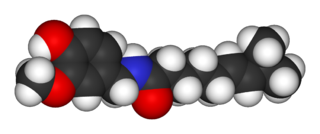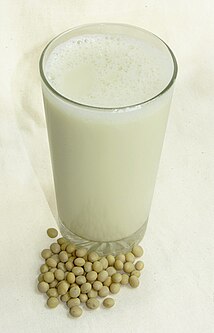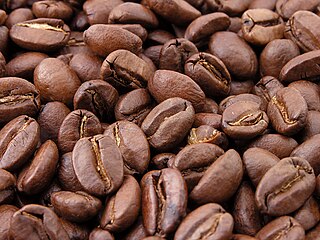Related Research Articles
A food flavoring, also known as an aromatic, is a food additive used to improve the taste or smell of food. It changes the perceptual impression of food as determined primarily by the chemical senses of the gustatory and olfactory system. The trigeminal nerves, which detect chemical irritants in the mouth and throat, as well as temperature and texture, are also important to the overall perception of food.

Capsaicin (8-methyl-N-vanillyl-6-nonenamide) is an active component of chili peppers, which are plants belonging to the genus Capsicum. It is a chemical irritant for mammals, including humans, and produces a sensation of burning in any tissue with which it comes into contact. Capsaicin and several related alkaloids are called capsaicinoids and are produced as secondary metabolites by chili peppers, probably as deterrents against certain mammals and fungi. Pure capsaicin is a hydrophobic, colorless, highly pungent, crystalline to waxy solid compound.

Sodium chloride, commonly known as salt, is an ionic compound with the chemical formula NaCl, representing a 1:1 ratio of sodium and chloride ions. With molar masses of 22.99 and 35.45 g/mol respectively, 100 g of NaCl contains 39.34 g Na and 60.66 g Cl. Sodium chloride is the salt most responsible for the salinity of seawater and of the extracellular fluid of many multicellular organisms. In its edible form of table salt, it is commonly used as a condiment and food preservative. Large quantities of sodium chloride are used in many industrial processes, and it is a major source of sodium and chlorine compounds used as feedstocks for further chemical syntheses. A second major application of sodium chloride is de-icing of roadways in sub-freezing weather.

Denatured alcohol is ethanol that has additives to make it poisonous, bad-tasting, foul-smelling, or nauseating to discourage its recreational consumption. It is sometimes dyed so that it can be identified visually. Pyridine and methanol, each and together, make denatured alcohol poisonous; and denatonium makes it bitter.

Retsina is a Greek white resinated wine, which has been made for at least 2,000 years. Its unique flavor is said to have originated from the practice of sealing wine vessels, particularly amphorae, with Aleppo Pine resin in ancient times. Before the invention of impermeable glass bottles, oxygen caused many wines to spoil within the year. Pine resin helped keep air out, while infusing the wine with resin aroma. The Romans began to use barrels in the 3rd century AD, removing any oenological necessity for resin, but the flavor itself was so popular that the style is still widespread today.

Soya milk also known as soy milk or soymilk, is a plant-based drink produced by soaking and grinding soybeans, boiling the mixture, and filtering out remaining particulates. It is a stable emulsion of oil, water, and protein. Its original form is an intermediate product of the manufacture of tofu. Originating in China, it became a common beverage in Europe and North America in the latter half of the 20th century, especially as production techniques were developed to give it a taste and consistency more closely resembling that of dairy milk. Soya milk may be used as a substitute for dairy milk by individuals who are vegan or are lactose intolerant.

Denatonium, usually available as denatonium benzoate and as denatonium saccharide (BITTERANT-s), is the most bitter chemical compound known, with bitterness thresholds of 0.05 ppm for the benzoate and 0.01 ppm for the saccharide. It was discovered in 1958 during research on local anesthetics by MacFarlan Smith of Edinburgh, Scotland, and registered under the trademark Bitrex.

Browning is the process of food turning brown due to the chemical reactions that take place within. The process of browning is one of the chemical reactions that take place in food chemistry and represents an interesting research topic regarding health, nutrition, and food technology. Though there are many different ways food chemically changes over time, browning in particular falls into two main categories: enzymatic versus non-enzymatic browning processes.
In psychology, aversives are unpleasant stimuli that induce changes in behavior via negative reinforcement or positive punishment. By applying an aversive immediately before or after a behavior the likelihood of the target behavior occurring in the future is reduced. Aversives can vary from being slightly unpleasant or irritating to physically, psychologically and/or emotionally damaging. It is not the level of unpleasantness or intention that matter, but rather the level of effectiveness the unpleasant event has on changing (decreasing) behavior that defines something as aversive.

Kilju is the Finnish word for fermented water. It is made of sugar, yeast, and water. Historically it used to be called sugar wine because it was sweetened with toppings such as citrus fruits, apples, berry juices, or artificial flavorings for legal reasons. Its alcohol content is usually 15–17% ABV.

A coffee bean is a seed of the Coffea plant and the source for coffee. It is the pip inside the red or purple fruit often referred to as a cherry. Just like ordinary cherries, the coffee fruit is also a so-called stone fruit. Even though the coffee beans are not technically beans, they are referred to as such because of their resemblance to true beans. The fruits; cherries or berries, most commonly contain two stones with their flat sides together. A small percentage of cherries contain a single seed, instead of the usual two. This is called a "peaberry". The peaberry occurs only between 10% and 15% of the time, and it is a fairly common belief that they have more flavour than normal coffee beans. Like Brazil nuts and white rice, coffee beans consist mostly of endosperm.

Allyl isothiocyanate (AITC) is the organosulfur compound with the formula CH2CHCH2NCS. This colorless oil is responsible for the pungent taste of mustard, radish, horseradish, and wasabi. This pungency and the lachrymatory effect of AITC are mediated through the TRPA1 and TRPV1 ion channels. It is slightly soluble in water, but more soluble in most organic solvents.

Quick bread is any bread leavened with a chemical leavening agent rather than a biological one like yeast or sourdough starter. An advantage of quick breads is their ability to be prepared quickly and reliably, without requiring the time-consuming skilled labor and the climate control needed for traditional yeast breads.

Soured milk denotes a range of food products produced by the acidification of milk. Acidification, which gives the milk a tart taste, is achieved either through bacterial fermentation or through the addition of an acid, such as lemon juice or vinegar. The acid causes milk to coagulate and thicken, inhibiting the growth of harmful bacteria and improving the product's shelf life.
The al-Abud Network is a former insurgent group who was operating within Iraq during the Iraq War. First reported in the "Comprehensive Report of the Special Advisor to the DCI on Iraq's WMD", the group is alleged to have attempted to acquire chemical weapons for use in fighting against Coalition Forces.
A bitterant is a chemical that is added to a product to make it smell or taste bitter. Bitterants are commonly used as aversive agents to discourage the inhalation or ingestion of toxic substances.

Instant soup is a type of soup designed for fast and simple preparation. Some are homemade, and some are mass-produced on an industrial scale and treated in various ways to preserve them. A wide variety of types, styles and flavors of instant soups exist. Commercial instant soups are usually dried or dehydrated, canned, or treated by freezing.
A bittering agent is a flavoring agent added to a food or beverage to impart a bitter taste, possibly in addition to other effects. While many substances are bitter to a greater or lesser degree, a few substances are used specifically for their bitterness, especially to balance other flavors, such as sweetness. Notable beverage examples include caffeine, found naturally in tea and coffee and added to many soft drinks, hops in beer, and quinine in tonic water.
The word denature means to render food unpleasant or dangerous to consume, it is denatured by adding a substance known as a denaturant. Aversive agents—primarily bitterants and pungent agents—are used to produce an unpleasant flavor. For example, the bitterant denatonium might be added to food used in a laboratory, where such food is not intended for human consumption. A poisonous substance may be added as an even more powerful deterrent. For example, methanol is blended with ethanol to produce denatured alcohol. The addition of methanol, which is poisonous, renders denatured alcohol unfit for consumption, as ingesting denatured alcohol may result in serious injury or death. Thus denatured alcohol is not subject to the taxes usually levied on the production and sale of alcoholic beverages. Aniline was used to denature colza oil in the 1980s.

Pungency is the condition of having a strong, sharp smell or flavor. It refers to the characteristic of food commonly referred to as spiciness, hotness or heat, found in foods such as chili peppers. Highly pungent tastes may be experienced as unpleasant.
References
- ↑ Final Report Study of Aversive Agents (PDF). Consumer Product Safety Commission United States of America. 18 November 1992. Archived from the original (PDF) on 16 June 2011. Retrieved 15 November 2010.